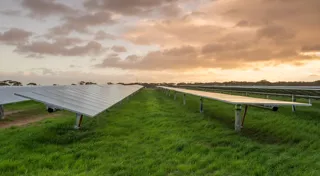CEFC to support emissions reduction across MIRA Australian infrastructure platform

15 October 2019
The Clean Energy Finance Corporation (CEFC) will work with Macquarie Infrastructure and Real Assets (MIRA), one of the world’s leading alternate asset managers, to pursue emissions reduction and energy efficiency across MIRA’s Australian infrastructure platform.
The CEFC is investing $100 million into MIRA’s Australian infrastructure platform and together with MIRA will target lower carbon emissions and improved energy efficiency at assets in sectors including airports, electricity, port, rail and water.
The emissions reduction standards will focus on identifying global best practice to drive positive change within the assets. Global best practice measures include Science Based Targets (SBT), which work to achieve the Paris Agreement commitment to limit global warming to well below two degrees Celsius from pre-industrial levels.
CEFC CEO Ian Learmonth said that infrastructure accounted for nearly half of Australia’s total greenhouse gas emissions.
“Investors and asset managers are more aware than ever that cutting emissions requires timely action across the economy, especially in a sector as substantial as infrastructure,” Mr Learmonth said.
“There are a range of proven technologies and strategies that can cut emissions in Australia’s diverse transport and energy assets and improve productivity and energy consumption. We recognise that these investments can be significant and need to work for the long term.
“We welcome this exciting emissions reduction focus from a substantial long-term investment manager such as MIRA and look forward to seeing these landmark Australian assets further developed to become an essential part of our sustainable future.”
Technologies and measures that can reduce emissions and energy use in infrastructure assets include:
- Installation of solar PV and batteries at airports, offices, warehouses and depot facilities
- Installation of solar PV at wireless communications infrastructure sites, which results in an integrated solar power solution to customers, to cut emissions as well as customer energy costs
- Building efficiency upgrades, including energy efficient lighting, demand management across heating, ventilation and cooling machinery and the replacement of hot water tanks
- Upgrades to efficient baggage handling systems and the provision of fixed ground power and pre-conditioned air at airports
- Replacement of vehicle fleets with electric vehicles at transport, distribution assets and airports
- Monitoring insulator gas loss to minimise transport and distribution resistance loss
- Demand management at transport and distribution assets.
MIRA Managing Director, Kieran Zubrinich, said ESG considerations are embedded within MIRA’s asset management frameworks and the investment from the CEFC will support decarbonisation strategies across its Australian platform.
“The responsibility we have as custodians of assets Australians use every day is to ensure their long-term sustainability and resilience for the benefit of the communities they serve.
“Our work with the CEFC will assist our assets to identify and achieve meaningful emissions reduction on a day to day basis, as well as improving operational performance and enhancing the services these businesses can provide,” Mr Zubrinich said.
CEFC Infrastructure lead Julia Hinwood said that the CEFC’s commitment to MIRA’s Australian infrastructure platform built on its existing relationship with MIRA. In February 2018 the CEFC committed $100 million to MIRA’s agricultural platform to demonstrate the broad potential of energy efficiency and low emissions technology in Australian farming.
“We look forward to working with MIRA to accelerate changes that will make substantial impacts in emissions reduction in infrastructure,” Ms Hinwood said.
The CEFC is a significant equity investor in emissions reduction projects across the vital infrastructure sector, including:
- $150 million equity in the IFM Australia Infrastructure Fund, managed by IFM Investors. The Fund has set emissions reduction targets through to 2030 and beyond across a portfolio of well-known assets including Ausgrid, Melbourne Airport, Brisbane Airport, NSW Ports (Botany and Kembla), the Port of Brisbane, Southern Cross Station in Melbourne and Northern Territory Airports.
- $150 million equity in the Morrison & Co Growth Infrastructure Fund, which is acquiring and developing a diverse range of essential assets – from hospitals to data centres, retirement and aged care accommodation to student housing and renewable energy – with the aim of progressively introducing SBTs to build a zero emissions portfolio.
- $150 million debt in freight and logistics company Qube Holdings Limited, which is developing the Moorebank Logistics Park in south-western Sydney, to take emissions-intensive trucks off Australian roads by increasing the use of rail networks to distribute containerised freight to and from Port Botany.
ABOUT MACQUARIE INFRASTRUCTURE AND REAL ASSETS
MIRA is one of the world’s leading alternative asset managers. For more than two decades, MIRA has partnered with investors, governments and communities to manage investments in assets relied on by more than 100 million people each day. As at 31 March 2019, MIRA had $A181.7 billion in assets under management, with many of those assets being essential to the sustainable development of economies and communities, including; 155 portfolio businesses, ~600 properties and 4.7 million hectares of farmland.
Media release, 2019




